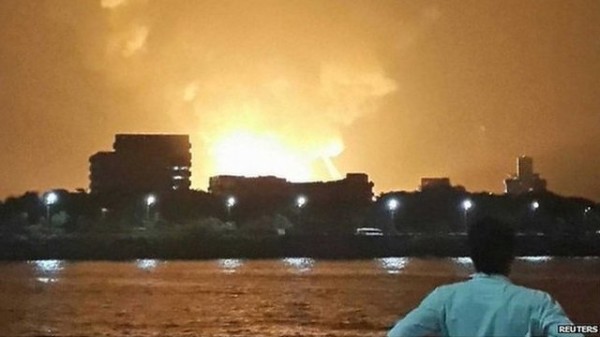Indian Defence Minister AK Antony has described two huge explosions and a fire on an Indian submarine berthed at a Mumbai dockyard as a “shocking tragedy”.
Navy chiefs earlier warned the families of 18 sailors on board the submerged vessel to “prepare for the worst” after the two near-simultaneous explosions.
Mr Antony offered “heartfelt condolences” to relatives of the dead.
It is not clear what caused the blasts. Sabotage has not been ruled out.
“A board of inquiry will cover the entire spectrum of the incident, we cannot rule out sabotage at this stage but all the indicators at this point do not support that theory,” navy chief Admiral DK Joshi said.
“Divers have opened the first hatch of the [submerged] submarine and are in the process of going down now. A detailed examination can only be carried out after the water is pumped out and the boat has come back to the surface.”
Earlier officials told the BBC they suspected the tragedy to be the result of an on-board error, not involving any outside agency.
Adm Joshi said that the boat has remained under water for much of Wednesday and that there had been no communication with the crew on board.
Scandal-hit military
No bodies have yet been recovered.
Correspondents say that India has steadily developed its naval capabilities in recent years, motivated by its rivalry with neighbouring China. But the country’s military has encountered numerous scandals and difficulties as it has done so.
On Tuesday the federal auditor suggested that the government may have paid too much for 12 helicopters from Anglo-Italian company AgustaWestland, saying procurement procedures designed to ensure value for money were not properly followed.
The blast on the INS Sindhurakshak took place after midnight (18:30 Tuesday GMT) and firefighters spent four hours putting out the blaze.
Officials said the diesel-powered vessel has been badly damaged.

As the emergency services rushed to the scene, it emerged that the explosion and fire had killed a number of crew members

The incident took place after midnight at the busy naval dockyard

Ships are moored at the Mumbai naval dockyard where the submarine caught fire after the explosion

The naval dockyard is a high-security zone where outsiders have little access

The authorities said there was no fear of any further explosions

An inquiry has been ordered into the causes of the incident
One navy official told the BBC that “surviving an explosion of this huge scale” was rare.
Many sailors managed to jump to safety after the blast. Some were taken to hospital.
Dramatic images on Indian television showed a large fireball illuminating the sky. Smoke from the blaze could be seen in many parts of the city.
The authorities have offered assurances that there is no fear of any further explosions.
The Russian-built submarine was upgraded recently at a cost of $80m (£52m). At the time of the explosion it was said to be fully loaded with ammunition.
Russian firm Zvyozdochka, which refitted the submarine, said the vessel had been fully operational when it was returned to India in January. Reports from Russia say specialists are ready to help with the aftermath.
‘Great loss’

Amateur video shown on Indian television showed a large fireball illuminating the sky
“It’s a great loss to us… it’s the greatest tragedy of recent times,” Mr Antony told reporters in Delhi before leaving for Mumbai to visit the site of the incident.
The INS Sindhurakshak, which is powered by diesel and electricity, is one of the 10 Kilo-class submarines bought from Russia between 1986 and 2000. It is equipped with Russian Club-S cruise missile systems.
The submarine was sent to Russia for the refit in 2010 after a sailor on board was killed by a fire that broke out in the battery compartment while the submarine was docked at the Vishakhapatnam naval base in February that year.
Wednesday’s explosion comes just days after India’s navy launched its first home-built aircraft carrier, hailed by defence officials as a “crowning glory”.
Last year, India bought a Russian Nerpa nuclear submarine for its navy on a 10-year lease from Russia at the cost of nearly $1bn, making it part of a select group of nations to operate nuclear-powered submarines.
India and Russia are long-time allies and Russia supplies about 70% of India’s military hardware.
INS Sindhurakshak timeline
- 1997: INS Sindhurakshak procured by Indian navy, one of the 10 vessels in the Kilo-class submarines bought from Russia between 1986-2000
- February 2010: A fire that broke out in its battery compartment kills one sailor
- August 2010: Submarine sent for re-fit to equip it with cruise missile systems
- June 2012: Refit completed with refurbished hull and 10 years added to its 25-year service life
- October 20102: Sea trials begin for submarine
- 14 August 2013: Submarine hit by explosion and fire with sailors feared trapped inside



Leave a reply